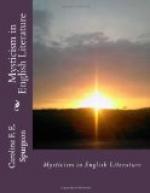Coventry Patmore was so entirely a mystic that it seems to be the first and the last and the only thing to say about him. His central conviction is the unity of all things, and hence their mutual interpretation and symbolic force. There is only one kind of knowledge which counts with him, and that is direct apprehension or perception, the knowledge a man has of Love, by being in love, not by reading about its symptoms. The “touch” of God is not a figure of speech.
“Touch,” says Aquinas, “applies to spiritual things as well as to material things.... The fulness of intelligence is the obliteration of intelligence. God is then our honey, and we, as St Augustine says, are His; and who wants to understand honey or requires the rationale of a kiss?” (Rod, Root, and Flower, xx.)
Once given the essential idea, to be grasped by the intuitive faculty alone, the world is full of analogies, of natural revelations which help to support and illustrate great truths. Patmore was, however, caught and enthralled by one aspect of unity, by one great analogy, almost to the exclusion of all others. This is that in human love, but above all in wedded love, we have a symbol (that is an expression of a similar force in different material) of the love between God and the soul. What Patmore meant was that in the relationship and attitude of wedded lovers we hold the key to the mystery at the heart of life, and that we have in it a “real apprehension” (which is quite different from real comprehension[13]) of the relationship and attitude of humanity to God. His first wife’s love revealed to him this, which is the basic fact of all his thought and work.
The relationship of the soul to Christ as His betrothed wife is the key to the feeling with which prayer and love and honour should be offered to Him ... She showed me what that relationship involves of heavenly submission and spotless passionate loyalty.[14]
He believed that sex is a relationship at the base of all things natural and divine;
Nature, with endless being
rife,
Parts each thing
into “him” and “her”
And, in the arithmetic of
life,
The smallest unit
is a pair.[15]
This division into two and reconciliation into one, this clash of forces resulting in life, is, as Patmore points out in words curiously reminiscent of those of Boehme, at the root of all existence. All real apprehension of God, he says, is dependent upon the realisation of his triple Personality in one Being.
Nature goes on giving echoes of the same living triplicity in animal, plant, and mineral, every stone and material atom owing its being to the synthesis or “embrace” of the two opposed forces of expansion and contraction. Nothing whatever exists in a single entity but in virtue of its being thesis, antithesis, and synthesis and in humanity and natural life this takes the




